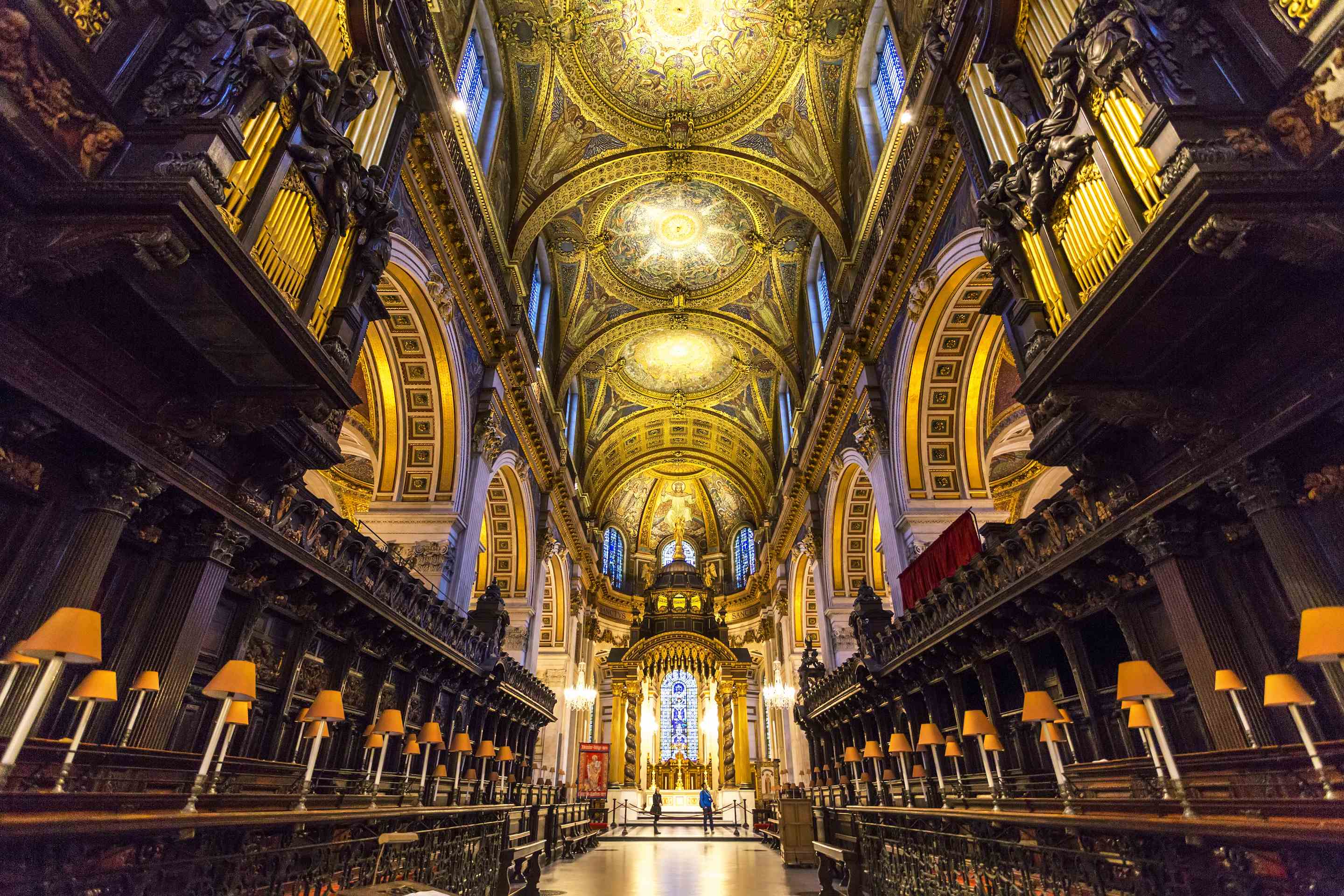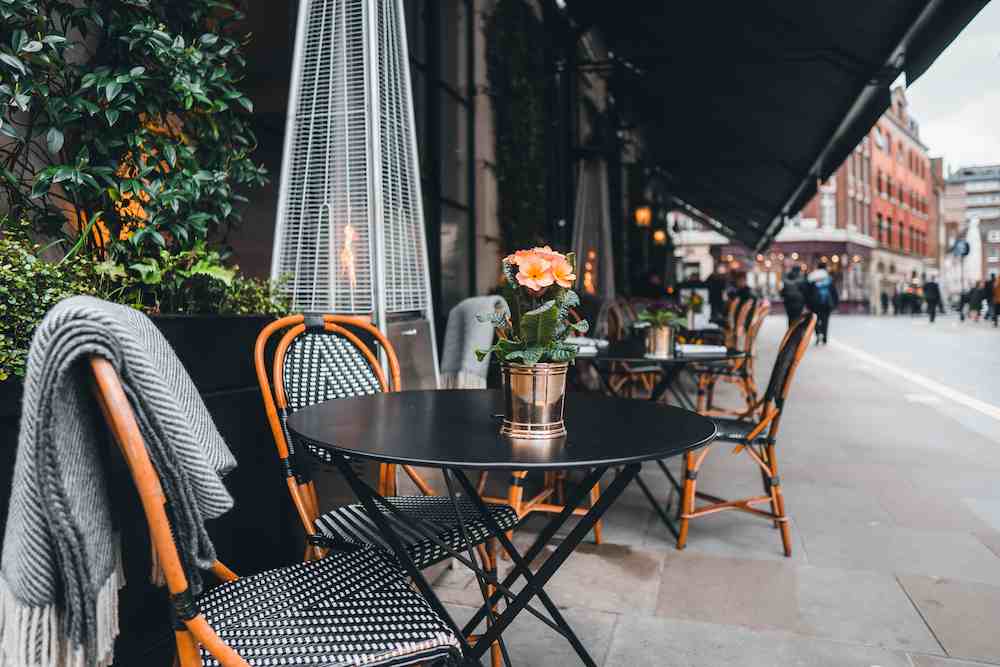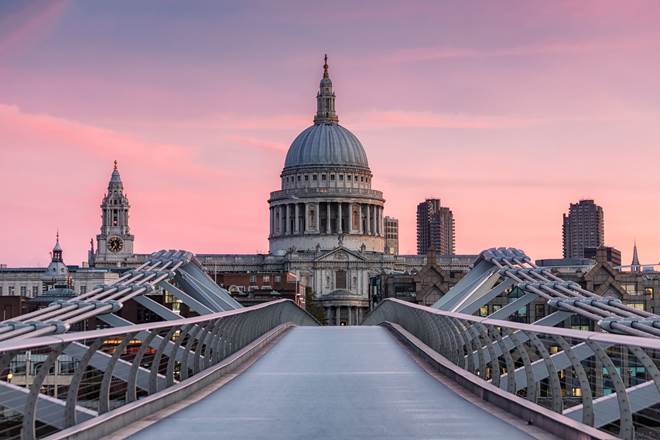What’s in this guide?
- What to see at St Paul’s Cathedral
- St Paul’s Cathedral history and facts
- Restaurants, bars and shops nearby
- Opening times and prices
Getting to St Paul’s Cathedral
Located in Central London, a short walk from the Tower of London and The Shard on the other side of the Thames, St Paul’s Cathedral is easy to get to using public transport. You can travel by bus, train or London’s underground transport system (tube).
The fastest way to get to this iconic building is by tube. Take the Central (red) line to St Paul’s station or the District (green) and Circle (yellow) lines to Mansion House or Blackfriars. Alternatively, you can take the Waterloo & City (turquoise) line to Bank and walk 10 minutes to St Paul’s.
If you prefer travelling by bus, plenty of lines will get you there. You can take the 4, 8, 11, 15, 17 and 23 lines to reach your destination. Find more information about bus routes here.
Getting to St Paul’s by train? Hop off at either City Thameslink, Blackfriars or Cannon Street station, which all lie a stone’s throw from the landmark. Or, you can take the train to Liverpool Street station and walk 20 minutes south towards the Thames.
What to see at St Paul’s Cathedral

With the second-largest dome in the world (a staggering 366-feet-high!), St Paul’s Cathedral is one of London’s oldest and most prominent monuments. Sir Christopher Wren began the design in 1675. He completed it in 1711 after the church commissioners turned down his first two proposals.
The imposing façade is complemented by the glorious décor on the inside, making St Paul’s one of the UK’s most emblematic masterpieces. Here are just a few things you can see in the building.
The Whispering Gallery
Around the Dome, 100 feet high, the Whispering Gallery is one of St Paul’s gems. It’s well worth the 259 steps you’ll need to climb to get there.
The gallery is famous for its unique acoustic properties. You can hear someone whispering no matter where they are in the gallery, thanks to the whispering waves – waves that travel across the circumference of the walls.
Another highlight of this gallery is its breathtaking views of the whole nave below, as well as Thornhill’s exquisite paintings. Fancy climbing some more steps? The Golden Gallery and the Stone Gallery on the outside of the Dome will reward your effort with stunning panoramas.
The Nave
This is by far one of the elements that make St Paul’s Cathedral a standout, where you really get to witness the grandeur of the building’s architecture. With the spectacular dome opening before you, you’ll also find the magnificent Great West Door – a 30-foot-tall space used for ceremonial purposes.
You’ll spot the monument dedicated to the Duke of Wellington when walking along the nave in the north aisle.
The Dome
Don’t let the 528 steps put you off; the climb is worth it. You simply can’t leave St Paul’s Cathedral without visiting its dome.
Famous for being the second-largest dome globally, the structure weighs about 65,000 tonnes. Wren was inspired by Michelangelo’s dome of St Peter’s Basilica when designing St Paul’s, with its one-of-a-kind three-dome structure.
Climbing to the top also means taking in some of the best views of the London skyline intersected by the Thames.
The Crypt
St Paul’s Crypt houses 200 memorials and numerous burials of notable people. The architect Christopher Wren was the first to be interred here, followed by Lord Nelson and the Duke of Wellington.
Nelson’s tomb is particularly famous, as it is made from the mast of the French flagship, L’Orient.
The exterior
Until the late 20th century, St Paul’s Cathedral was the tallest monument of London’s skyline, with its majestic Dome soaring up 365 feet. The building’s exterior is just as elegant as the interiors, dominated by the West Front and the statue of St Paul.
The two Baroque towers lie at the side of the entrance. One of them houses Great Paul – England’s largest bell.
St Paul’s Cathedral history and facts
Despite a turbulent past, St Paul’s Cathedral has lived through three centuries and today stands proud in the heart of London as a symbol of resilience and hope. It sits on the highest point in the City of London, with its historic blue dome standing out against the skyline.
Pre-Norman Cathedral
The first church was built by King Ethelbert of Kent on Ludgate Hill in 604 AD, dedicated to the apostle Paul. The wooden structure was used as the seat of the new bishop but was destroyed by fire.
The church was rebuilt between 675 AD and 685 AD but was invaded by the Vikings in 962 and severely damaged. The monument was once again rebuilt and then burnt down. In 1087, the Normans began the construction of Old St Paul’s.
Old St Paul’s
The fourth version of St Paul’s, commonly referred to as Old St Paul’s, was built by the Normans after the fire of 1087. The new design differed from the previous ones, shifting from Romanesque to Gothic. This was evident in the pointed arches and the more oversized windows.
Like York Minster, the Old St Paul’s also had a gothic ribbed vault made of wood rather than stone. However, this material led the monument to be more prone to damage.
The quire was the first area to be completed in 1148, so the building could function as a place of worship. It took 150 years to complete the design, with a third choir being added in 1313, making the Old St Paul’s Cathedral the longest in Europe. It was also the tallest when the spire was complete, measuring 489 feet high.
In 1335, a fire disrupted construction, and by the 16th century, the building began to decay. The spire was destroyed by lightning, and the Civil War brought St Paul’s to a state of ruin. The Great Fire of London in 1666 completely destroyed the structure. It would have been possible to rebuild it again, but the church commissioners decided to create a new one.
The new St Paul’s
The new St Paul’s design was assigned to Britain’s most notable architect, Sir Christopher Wren, in 1669. Wren was also responsible for the construction of Kensington Palace in Hyde Park. It took nine years of planning for the monument to be finally consecrated for use in 1697. It was officially approved by Parliament in December 1711.
A 15-year renovation project was commissioned at the end of the 20th century, with copper, slate and lead used extensively. The restoration was completed in June 2011. Today, St Paul’s attracts around 2 million visitors a year from all over the world and is an emblem of perseverance and love for the nation.
Restaurants, bar and shops near St Paul’s Cathedral

St Paul’s Cathedral is in the heart of London, which means you’ll have plenty of restaurants and bars on your doorstep when you visit. Whether you’re in the mood for some drinks or want to take the weight off and refuel, the capital’s cuisine suits all tastes. And if you fancy a spot of shopping afterwards, the city’s best areas are within easy reach.
Best restaurants near St Paul’s Cathedral
St Paul's area boasts excellent eateries, from upscale restaurants to casual gems serving the best British and international cuisine. We’ve rounded up some of the best around:
- Lamb and Trotter
- Magpie & Stump
- Bread Street Kitchen
- Balfour St Bart’s
- Rucoletta
- Mangio Pasta & Bottega
- Cabotte
- Paternoster
- Epic Pies
- Pilpel
Best bars near St Paul’s Cathedral
If you fancy a glass of wine or a cocktail to complete your day of sightseeing, here’s where you need to visit:
- The Old Change Bar & Kitchen
- Madison
- Shaws Booksellers
- Patch St Paul’s
- Sabine Rooftop Bar
- Ye Olde London
- The Paternoster
- Artigiano Espresso & Wine Bar
- Enoteca da Luca
Best stores near St Paul’s Cathedral
In the mood for some window shopping? Or are you in need of some last-minute gifts? St Paul’s Cathedral area is studded with shops to cater for all tastes and budgets. From high-street favourites to independent stars, discover some of the best shopping in London when you explore the area. Or hop on the tube to one of London’s famous shopping streets!
Opening times and prices
St Paul’s Cathedral is open from Monday to Saturday between 10:30 and 16:30.
The price of admission includes a visit to the Cathedral, the Dome Galleries and the Crypt. General admission begins at £18 per person online, and £21 per person if purchased on the Cathedral’s website. There are also various concessions available:
|
Concession |
Online tickets |
Walk-up tickets |
Group (10+) tickets |
|
Students |
£16 |
£18.50 |
£16 |
|
Over 65 |
£16 |
£18.50 |
£16 |
|
Children (6-17) |
£7.70 |
£9 |
£7.70 |
|
Family (2 adults + 2 children) |
£43.70 |
£51 |
- |
|
Family (1 adult + 2 or 3 children) |
£30.70 |
£36 |
- |
Find more information about ticket prices here.
Travelling by train to London?
If you want to spend some time in the capital of England, why not take the train? Travelling to London by train is simple due to the high-speed rail connections operated by 28 major train companies across the UK. You can travel to London from some of the most popular cities in Europe, including Paris to London (2h 17m), Edinburgh to London (4h) and Amsterdam to London (4h 42m).
Need more information about travelling to London by train? Check out our dedicated page to trains to London.
